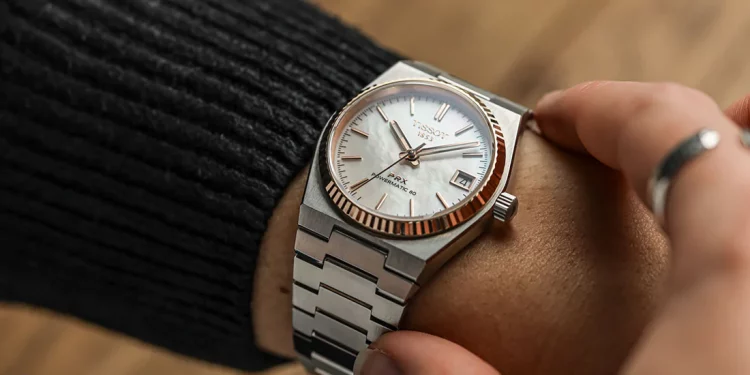Introduction
Tissot watches, renowned for their precision, craftsmanship, and timeless elegance, deserve meticulous care to ensure they maintain their value and performance over time. But how exactly can you keep your Tissot watch running like new? From regular cleaning to professional servicing, this detailed guide explores everything you need to know about maintaining and preserving your Tissot timepiece.
1. Understanding Your Tissot Watch: Types and Maintenance Needs
1.1 Quartz vs. Mechanical Movements
- Quartz Watches: Powered by a battery and require fewer servicing intervals.
- Mechanical Watches: Require regular winding and more frequent maintenance due to their intricate components.
1.2 Automatic vs. Manual Mechanical Watches
- Automatic Watches: Use kinetic energy from wrist movements and may require winding if not worn regularly.
- Manual Watches: Require daily winding for optimal performance.
1.3 Specialized Models and Unique Care Needs
- T-Touch Series: Includes digital elements and tactile functionalities, necessitating specialized care.
- Diver Watches: Require additional checks to maintain water resistance.
2. Daily Habits for Maintaining Your Tissot Watch
2.1 Proper Wearing Practices
- Avoid exposing your watch to excessive vibrations or impacts.
- Always ensure the crown is fully pushed in or screwed down to maintain water resistance.
2.2 Keeping Your Watch Clean
- Use a soft, lint-free cloth to wipe the case and bracelet after daily use.
- For metal bracelets, use a soft brush and mild soap with water for a deeper clean.
2.3 Storing Your Watch Correctly
- Store in a cool, dry place away from direct sunlight and magnetic fields.
- Consider a watch box or pouch to prevent scratches.
3. Water Resistance and Its Role in Maintenance
3.1 Understanding Water Resistance Ratings
- 30m (3 ATM): Splash-resistant but not suitable for swimming.
- 50m–100m: Safe for swimming and shallow snorkeling.
- 200m+: Suitable for professional diving.
3.2 Testing and Maintaining Water Resistance
- Regularly check seals and gaskets, especially after exposure to water.
- Perform a water resistance test every 12–24 months at an authorized service center.
3.3 Avoiding Common Water-Related Mistakes
- Never operate the crown or pushers while the watch is wet.
- Rinse your watch with fresh water after exposure to saltwater or chlorine.
4. Battery Replacement for Quartz Watches
4.1 Signs Your Battery Needs Replacement
- The second hand starts jumping in intervals (end-of-life indicator).
- The watch stops functioning altogether.
4.2 The Importance of Professional Battery Replacement
- Avoid DIY replacements to prevent damage to internal components.
- Certified technicians ensure proper resealing for water resistance.
4.3 Eco-Friendly Disposal
Dispose of used batteries responsibly by recycling them at designated centers.

5. Servicing Your Tissot Watch: When and Why
5.1 Recommended Service Intervals
- Quartz Watches: Every 3–5 years.
- Mechanical Watches: Every 3–4 years for optimal performance.
5.2 What Happens During a Full Service?
- Disassembly and cleaning of the movement.
- Lubrication and replacement of worn parts.
- Calibration of timekeeping accuracy.
- Case and bracelet polishing.
5.3 Costs and Authorized Service Centers
- Expect higher costs for mechanical watches and specialized models.
- Always choose an authorized Tissot service center to maintain warranty and authenticity.
6. Protecting Your Watch from Environmental Factors
6.1 Temperature Extremes
- Avoid exposing your watch to temperatures above 60°C (140°F) or below -10°C (14°F).
- Sudden temperature changes can cause condensation inside the case.
6.2 Magnetic Fields
- Keep your watch away from strong magnets, such as speakers and smartphones.
- Mechanical watches can lose accuracy due to magnetic interference.
6.3 Shock and Vibration
- Avoid dropping or banging your watch against hard surfaces.
- Use shock-resistant models for sports or high-impact activities.
7. Maintaining Watch Straps and Bracelets
7.1 Caring for Metal Bracelets
- Clean regularly with mild soap and water.
- Check for loose links or clasps and have them repaired promptly.
7.2 Caring for Leather Straps
- Avoid prolonged exposure to water and sweat to prevent damage.
- Use a leather conditioner to keep the strap supple.
7.3 Replacing Straps
- Tissot offers a variety of replacement straps to match your watch’s design.
- Ensure proper sizing and fitting by a professional.
8. DIY Maintenance Tips and When to Seek Professional Help
8.1 Simple At-Home Maintenance
- Regular cleaning of the case and bracelet.
- Periodic winding for manual watches.
8.2 Identifying Potential Issues
- Loss of time accuracy.
- Moisture under the crystal.
- Unusual noises or difficulty in winding.
8.3 Knowing When to Visit a Professional
- For any internal repairs or adjustments.
- For regular servicing and water resistance tests.
9. Sustainability in Watch Maintenance
9.1 Longevity and Sustainability
- Proper maintenance ensures your watch lasts for decades, reducing waste.
9.2 Eco-Friendly Materials
- Tissot’s commitment to sustainability extends to its materials and practices.
9.3 Contributing to a Circular Economy
- Reuse and recycle old parts through authorized service centers.
Conclusion
How can you keep your Tissot watch running like new? The answer lies in a combination of daily care, periodic servicing, and mindful practices. Whether it’s cleaning the case, protecting against water damage, or choosing the right storage solution, each step contributes to the longevity and performance of your timepiece.
By following this comprehensive guide, you not only preserve the elegance and functionality of your Tissot watch but also honor the craftsmanship and legacy it represents.





































